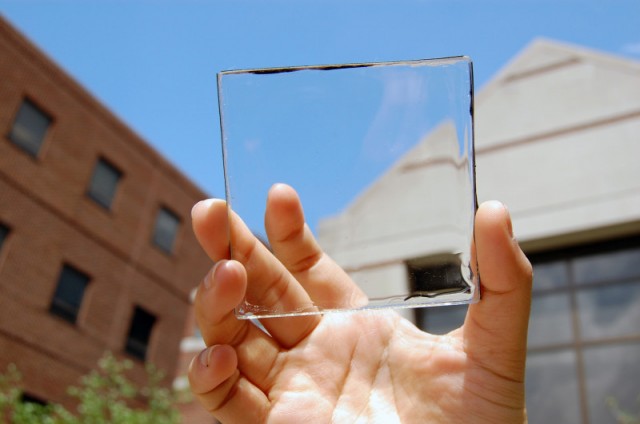Michigan State University researchers have developed an entirely transparent solar concentrator that can basically transform any glass surface into a photovoltaic solar cell; thus you could have your own “solar window”. This type of solar cell is indeed transparent, unlike many other pseudo-transparent cells that have been engineered in the past.
The leading researcher on the project, Richard Lunt, and his team are very excited about their results. The appliance for such a technology is quite widespread as it can be used, he states, for “tall buildings with lots of windows or any kind of mobile device that demands high aesthetic quality like a phone or e-reader.” Of course this doesn’t stop here, anything from your bedroom window, to a green-house encasing or your laptop screen can become self-sustainable energy sources.
In scientific terms a transparent solar panel is somewhat of a peculiar paradox. Photovoltaic cells in general create energy by taking in photons (sunlight particles) and transforming them into electrons (electric power). However if the a material is transparent the light has unobstructed passage through it, being nearly impossible for it to retain any of the photons. This is the main reason that all the previous solar panel cells have not been entirely transparent.

To work around this constraint in order to create the solar window, the research team at Michigan state made use of a different technique in order to gather photons. They used a “transparent luminescent solar concentrator”, TLSC for short. The TLSC is comprised out of organic salts that absorb invisible ultraviolet and infrared light wavelengths, which then they render as another wavelength of infrared light. The resulting infrared light is sent to the plastic edge where regular, photovoltaic solar cells transform it into electric power. The principle used to harvest sunlight in this manner is named Near-Infrared Harvesting Transparent Luminescent Solar Concentrators.
The TLSC solar window developed by Michigan State is currently capacitated at 1 %, but the team believes it possible to be able to reach an efficiency rate of 5 %, while the non-transparent “solar window” can go up to 7%. All of these figures standing alone may not have much meaning, but if you sum up the capacity of a window-pane office building to make use of this tech you can imagine that the figures add up quite nicely. In the case of smart-phones, tablet or any other screen-using device the effect might even not be that huge, in the best case scenario increasing its autonomy by a few minutes to several hours on one charge.
The team of researchers at Michigan State are more than confident that the solar window can leave its mark in the world. Being a very flexible type of tech it can be used from household to a full industrial level. Further developments in this niche are expected and the application of the technology to a larger scale is only a matter of time. The solar window might just be the next big thing in terms of renewable energy and we have yet to see its full potential.
